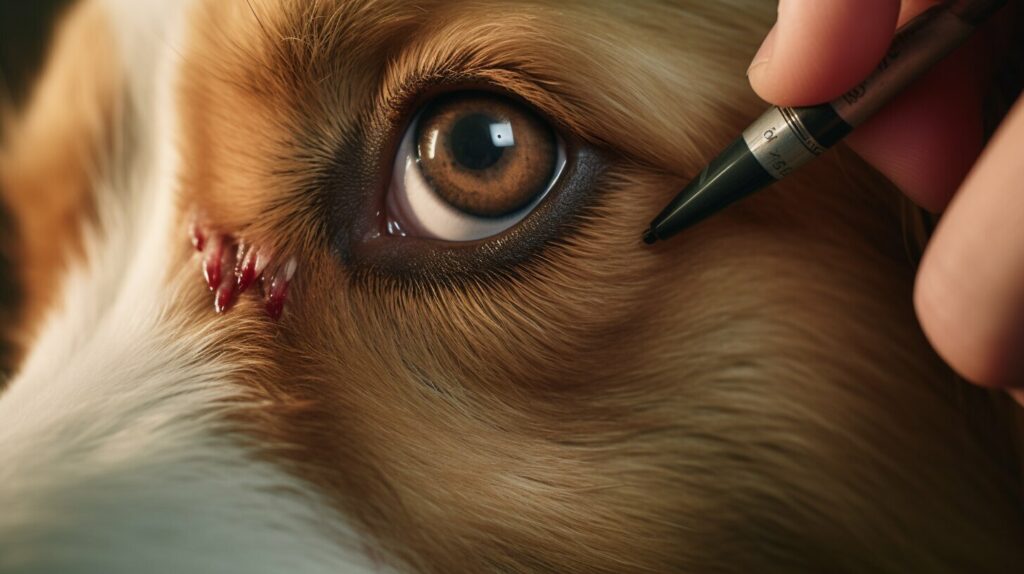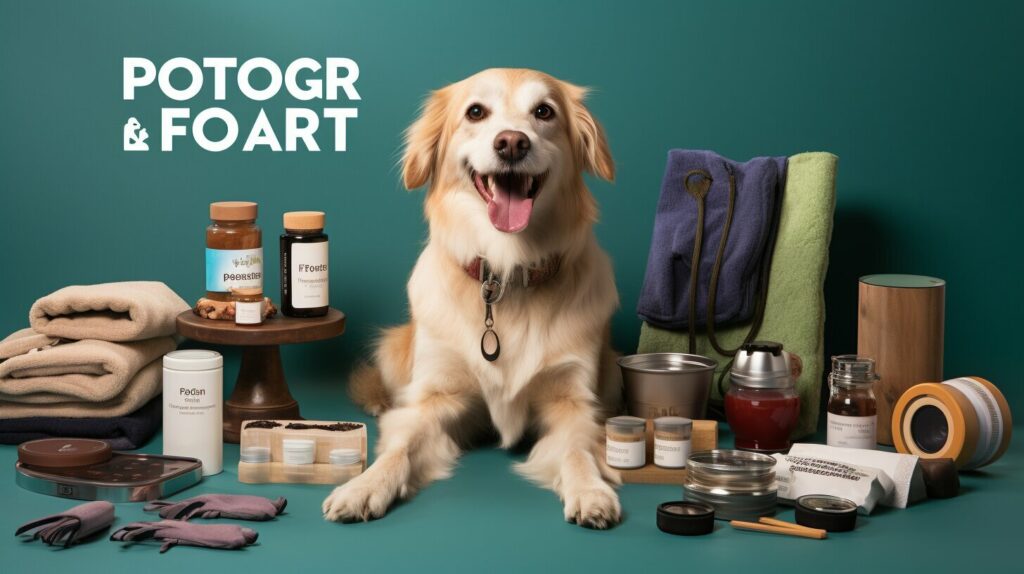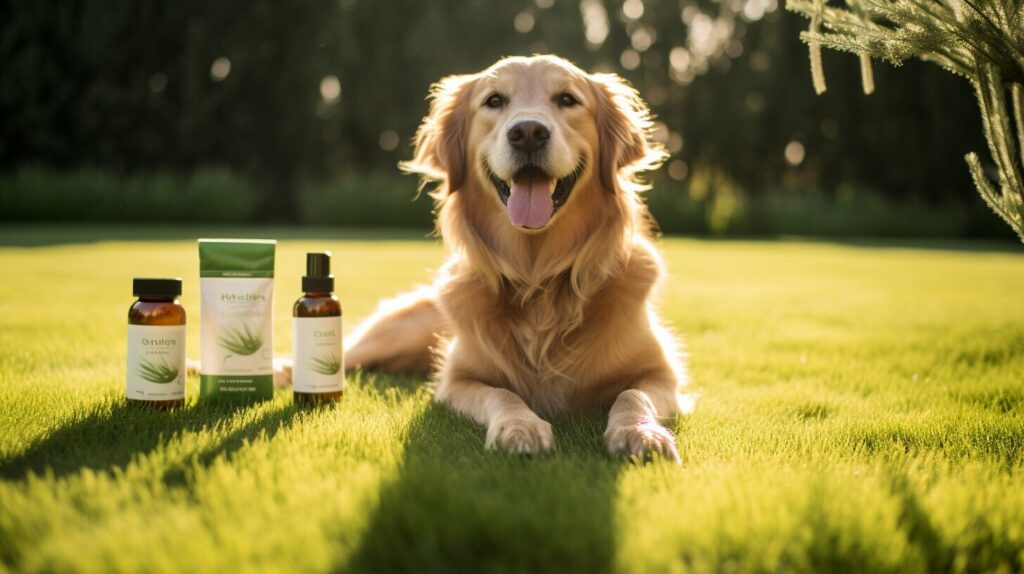Dogs are beloved members of our families, and we want to do everything we can to keep them healthy and happy. Part of that responsibility includes taking care of their eyes and monitoring any potential issues, including eyelid infections. In this article, we will discuss what eyelid infections are, how to identify them, and the various treatment options available for managing the condition.
Key Takeaways:
- Eyelid infections can impact a dog’s overall eye health and wellbeing
- Common symptoms of eyelid infections in dogs include redness, swelling, and discharge
- Veterinary care is crucial for proper diagnosis and treatment of eyelid infections, with potential treatment options including topical ointments, oral medications, and surgery
- Proactive measures, such as proper hygiene practices and regular eye exams, can help prevent eyelid infections in dogs
Understanding Eyelid Infections in Dogs
If you’re a dog owner, you know how important it is to keep your furry friend healthy and happy. One crucial aspect of dog health is eye care, and eyelid infections in dogs are a common issue that can impact their overall well-being. Understanding the causes, symptoms, and treatment options for canine eyelid infections is crucial for protecting your dog’s eye health.
Canine eyelid infections can occur due to a variety of reasons, including allergies, bacterial or fungal infections, or trauma to the eye. Dogs with certain breeds, such as pugs and bulldogs, may be more susceptible to eyelid infections due to the shape of their eyes. Eyelid infections can also be a secondary issue caused by other underlying conditions like conjunctivitis or corneal ulcers.
Some common symptoms of a canine eyelid infection may include redness and swelling of the eyelid, discharge or crusting around the eye, excessive tearing or dryness, and changes in the appearance of the eyelid. These symptoms can be uncomfortable for your dog and can lead to further complications if left untreated.
The good news is that veterinary treatment for eyelid infection in dogs is highly effective, and there are many options available depending on the severity and underlying cause of the infection. Treatment may include topical or oral medications to address any bacterial or fungal infections, and in more severe cases, surgery may be necessary to correct any abnormalities or relieve pressure on the eye.
Ultimately, the best way to prevent eyelid infections in dogs is to maintain proper eye care and hygiene. This includes regularly cleaning the area around your dog’s eyes, keeping their bedding and environment clean, and seeking veterinary attention promptly if any concerning symptoms arise. With proper care and treatment, your dog’s eyes can remain healthy and bright, allowing them to enjoy all the sights and smells of the world around them.
Symptoms of Eyelid Infection in Dogs
As a responsible dog owner, it’s important to be aware of the signs and symptoms that may indicate an eyelid infection in your furry friend. While these infections are typically not life-threatening, they can be uncomfortable for your dog and may lead to more serious health concerns if left untreated.
One of the most common symptoms of an eyelid infection in dogs is redness or swelling around the affected eye. You may notice that your dog’s eyelid appears to be more puffy than usual or that there is discharge coming from the eye. Your dog may also be rubbing or scratching at their eye, indicating discomfort or irritation.
In some cases, the appearance of the eyelid itself may change. You may notice that the eyelid becomes thickened or that there is a bump or growth on the lid. Your dog’s eye may also appear to be droopy or partially closed, which can signal a problem with the eyelid muscles.
If you notice any of these symptoms in your dog, it’s important to seek veterinary attention as soon as possible. Your veterinarian can perform a thorough examination to determine the underlying cause of your dog’s symptoms and recommend appropriate treatment options.
Diagnosing Eyelid Infection in Dogs
If you suspect that your dog may be suffering from an eyelid infection, it is important to seek veterinary attention promptly. Your veterinarian will conduct a thorough examination of your dog’s eye to determine the cause of the infection and establish an appropriate treatment plan.
The diagnostic process may involve a physical examination of the eye, including an assessment of the eyelid itself. Your veterinarian may also take a sample of any discharge present to send for laboratory testing. In some cases, a biopsy of the affected tissue may also be recommended.
| Common diagnostic methods for eyelid infections in dogs: | |
|---|---|
| Physical examination | Your veterinarian will visually inspect the affected eye and eyelid for signs of infection or inflammation. |
| Laboratory testing | A sample of discharge may be taken and sent for analysis to determine the presence of any bacteria or fungi causing the infection. |
| Biopsy | In some cases, a biopsy of the affected tissue may be necessary to confirm the diagnosis and rule out any underlying conditions or tumors. |
Effective veterinary treatment of eyelid infections in dogs depends on an accurate diagnosis and timely intervention. If you suspect your dog may be suffering from an eyelid infection, contact your veterinarian as soon as possible to ensure they receive prompt and appropriate care.
Treating Eyelid Infection in Dogs
There are several treatment options available for managing eyelid infections in dogs, and the type of treatment your dog receives will depend on the severity and underlying cause of the infection. It’s important to seek veterinary treatment as soon as possible to prevent the infection from worsening and potentially causing further damage to your dog’s eye health.
Medical treatments: This may include topical ointments or oral medications, such as antibiotics or antifungal medications, to address the underlying infection. Your veterinarian may also recommend eyelid scrubs or warm compresses to help reduce inflammation and promote healing.
Surgical interventions: In more severe cases, surgery may be necessary to remove any infected tissue or address any structural abnormalities that are contributing to the infection. Your veterinarian can discuss the potential risks and benefits of surgery and help you make an informed decision.
If you suspect your dog may have an eyelid infection, it’s important to seek veterinary attention promptly for proper diagnosis and treatment. Ignoring the issue can lead to more serious complications, including permanent vision loss.
In addition to veterinary treatment, there are also some home remedies that dog owners can consider, such as chamomile tea bags or diluted tea tree oil, but it’s important to consult with your veterinarian before trying any home remedies to ensure they are safe and effective.
Home Remedies for Dog Eyelid Infection
While veterinary treatment is essential in managing eyelid infections in dogs, there are some home remedies that may also help in conjunction with professional care. However, it is crucial to consult with your vet before trying any of these remedies to ensure they are safe and effective for your pet.
1. Warm Compress: A warm compress can help reduce inflammation and swelling of the eyelid. Soak a clean washcloth in warm water and place it over your dog’s affected eye for five to ten minutes several times a day.
2. Chamomile Tea: Chamomile tea has natural anti-inflammatory and antibacterial properties that can soothe a dog’s eyelid infection. Brew a chamomile tea bag in hot water and let it cool. Then, use a dropper to apply a few drops of the tea to your dog’s eye a few times a day.
3. Apple Cider Vinegar: Apple cider vinegar has antimicrobial properties that make it a popular home remedy for various infections, including eyelid infections in dogs. Mix a teaspoon of apple cider vinegar with a cup of water and use a clean cloth to apply it to your dog’s eye a few times a day.
4. Aloe Vera: Aloe vera has natural antibacterial and anti-inflammatory properties that can help reduce inflammation and soothe your dog’s eyes. Apply a small amount of aloe vera gel to your dog’s affected eye a few times a day.
5. Vitamin E: Vitamin E oil has antioxidant properties that can help reduce swelling and inflammation of the eyelid. Apply a small amount of vitamin E oil to your dog’s affected eye a few times a day.
Remember, while home remedies can be useful, they should never replace veterinary care. If your dog’s eyelid infection does not improve or worsens, seek veterinary attention immediately.
Preventing Eyelid Infections in Dogs
As a dog owner, it is crucial to take preventive measures to reduce the risk of eyelid infections. By practicing good dog eye care, you can help keep your furry friend’s eyes healthy and free from infections. Here are some tips to help you get started:
- Keep the eye area clean: Cleaning your dog’s face regularly can help prevent debris, dirt, and bacteria from accumulating around the eyes, which can cause an infection. Use a damp cloth or special wipes made specifically for dogs to clean the area around the eyes.
- Regular eye exams: Bring your dog to the veterinarian for regular check-ups and eye exams. This can help detect any potential issues, including eyelid infections, early on, before they become more serious.
- Avoid irritants: Certain irritants, such as smoke or chemicals, can cause eye irritation and infection. Avoid exposing your dog to these irritants as much as possible.
- Proper nutrition: A healthy diet is essential for maintaining good eye health in dogs. Make sure your pet is getting a balanced and nutritious diet, which can help prevent infections and other eye-related issues.
Remember that prevention is always better than cure. By taking these simple preventive measures, you can help keep your dog’s eyes healthy and free from infections.
Importance of Regular Veterinary Check-ups for Dog Eye Health
Regular veterinary check-ups play a crucial role in maintaining optimal eye health in dogs. Your veterinarian can detect and address potential issues, such as eyelid infections, before they escalate and cause more significant health problems.
During a routine examination, your veterinarian will examine your dog’s eyes for any signs of infection, inflammation, or other abnormalities. If an eyelid infection is suspected, they may perform additional tests, such as a physical examination, laboratory tests, or even a biopsy, to confirm the diagnosis.
If your dog is diagnosed with an eyelid infection, your veterinarian will determine the best course of treatment based on the severity of the infection. This may involve medical treatments, such as topical ointments or oral medications, or surgical interventions if the condition is more advanced.
Even after the infection has been treated, it is important to continue regular veterinary check-ups to ensure your dog’s eye health is maintained and to detect any potential issues before they become more severe. Your veterinarian may recommend more frequent eye exams if your dog is prone to eye infections or other eye conditions.
Remember, prevention is always the best approach when it comes to your dog’s eye health. In addition to regular veterinary check-ups, be proactive about maintaining good eye care practices at home. This includes keeping the eye area clean, avoiding potential irritants, and monitoring any changes or abnormal symptoms.
Common Eye Conditions in Dogs
Dogs are prone to a variety of eye conditions, including infections, injuries, and degenerative diseases. As an attentive dog owner, it’s essential to monitor your dog’s eyes for any signs of discomfort or abnormalities regularly. Here are some common eye conditions that dogs may experience:
Conjunctivitis
Conjunctivitis, also known as “pink eye,” is a highly contagious condition that affects the conjunctiva, the thin membrane lining the eye and eyelid. Dogs with conjunctivitis may have red, swollen, or watery eyes and may experience discharge or crusty debris around the eye area.
Corneal Ulcers
Corneal ulcers are painful sores that develop on the cornea, the transparent outer layer of the eye. This condition is often caused by trauma or scratches to the surface of the eye and can lead to discomfort, excessive tearing, or light sensitivity.
Canine Eyelid Infection
Eyelid infections in dogs are typically caused by bacterial or fungal pathogens and can lead to symptoms such as redness, swelling, itching, or discharge. Keeping your dog’s eye area clean and seeking prompt veterinary care is crucial for effectively treating eyelid infections.
Regular eye exams, coupled with proper hygiene and care, can help catch these conditions early and prevent them from turning into more severe issues that may require surgery or long-term medical treatment. Ultimately, protecting your furry companion’s eye health is key to ensuring they enjoy a happy, healthy life.
Caring for Your Dog’s Eyes
Dogs rely heavily on their eyesight, so it’s essential to prioritize their eye health as part of their overall care. Here are some practical tips for maintaining good eye health in your furry friend:
- Keep the eye area clean: Regularly wiping around your dog’s eyes with a damp cloth can prevent the buildup of dirt and debris, which can irritate the eyes and increase the risk of infection.
- Address potential irritants: Dogs can be sensitive to certain substances, such as pollen or cleaning products, which can trigger eye irritation. Avoid exposing your dog to potential irritants, and seek veterinary attention if you notice any signs of eye irritation.
- Monitor for changes: Be proactive about monitoring any changes or abnormalities in your dog’s eyes, such as redness, swelling, or discharge. Contact your veterinarian if you notice any concerning symptoms.
- Regular veterinary check-ups: Schedule regular check-ups with your veterinarian to monitor your dog’s eye health and address any potential issues before they escalate.
By following these simple tips and working closely with your veterinarian, you can help ensure your dog’s eyes stay healthy and free of infection.
Conclusion
As a responsible dog owner, it’s important to be aware of the potential risks and health issues that can impact your furry friend. Eyelid infections in dogs are a common condition that can cause discomfort and lead to more severe eye health problems if left untreated.
If you notice any symptoms of an eyelid infection, such as redness, swelling, discharge, or changes in the appearance of the eyelid, it’s crucial to seek veterinary attention promptly. Your veterinarian can examine and diagnose the condition, and develop a tailored treatment plan that may include medical or surgical interventions.
Alongside veterinary care, there are some home remedies that may help alleviate symptoms and support healing. However, it’s essential to consult with your vet before trying any home remedies to ensure they are safe and effective.
Prevention is always better than cure, and there are steps you can take to reduce the risk of eyelid infections in dogs. Proper hygiene practices, maintaining a healthy diet, and regular eye exams can all help keep your dog’s eyes in good condition.
Regular veterinary check-ups are also crucial for maintaining optimal eye health in dogs. Routine examinations can help detect and address potential issues, including eyelid infections, before they escalate.
By prioritizing good eye care practices and promptly addressing eyelid infections, you can help ensure that your dog’s eyes stay healthy and bright, promoting their overall wellbeing and happiness.
FAQ
Q: How can I identify an eyelid infection in my dog?
A: Look for symptoms such as redness, swelling, discharge, and changes in the appearance of the eyelid. If you notice these signs, it’s important to seek veterinary attention.
Q: How are eyelid infections in dogs diagnosed?
A: Veterinarians typically examine and evaluate the condition through a physical examination, laboratory tests, and potentially, a biopsy.
Q: What treatments are available for eyelid infections in dogs?
A: Treatment options may include topical ointments, oral medications, and potential surgical interventions. Your veterinarian will determine the best course of action based on the severity of the infection.
Q: Are there any home remedies I can try for my dog’s eyelid infection?
A: It’s important to consult with a veterinarian before attempting any home remedies. They can provide guidance on safe and effective options to complement veterinary treatment.
Q: How can I prevent eyelid infections in my dog?
A: Practicing proper hygiene, scheduling regular eye exams, and maintaining a healthy diet are key preventive measures to reduce the risk of eyelid infections in dogs.
Q: Why are regular veterinary check-ups important for dog eye health?
A: Regular check-ups allow veterinarians to monitor and address any potential eye health issues, including eyelid infections, before they escalate.
Q: What are some other common eye conditions in dogs?
A: Other common eye conditions in dogs include conjunctivitis and corneal ulcers. Proper eye care and veterinary monitoring are crucial for overall eye health.
Q: How can I care for my dog’s eyes?
A: Keeping the eye area clean, addressing any potential irritants, and being proactive about monitoring changes or abnormalities in the eyes are important for maintaining good eye health in dogs.



